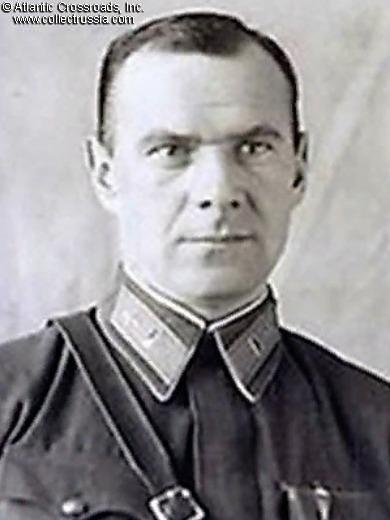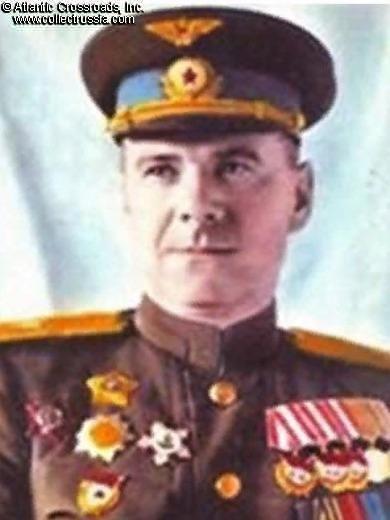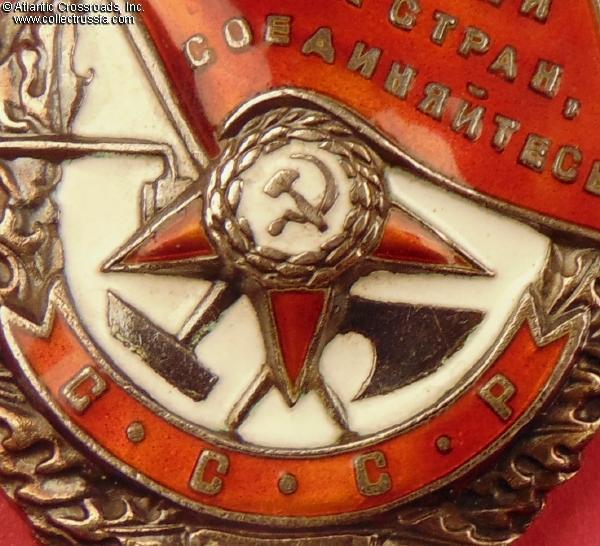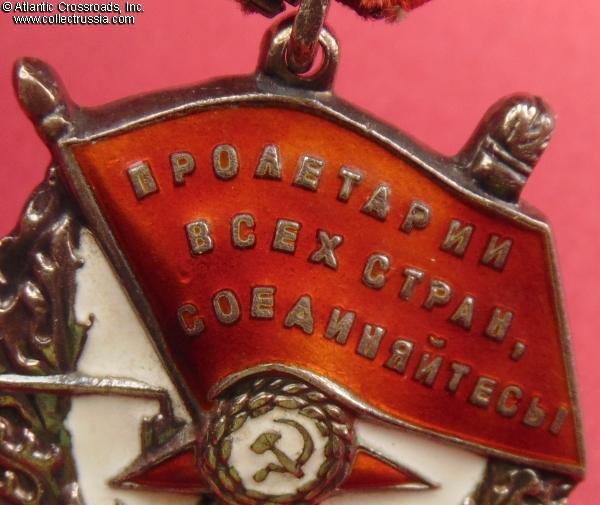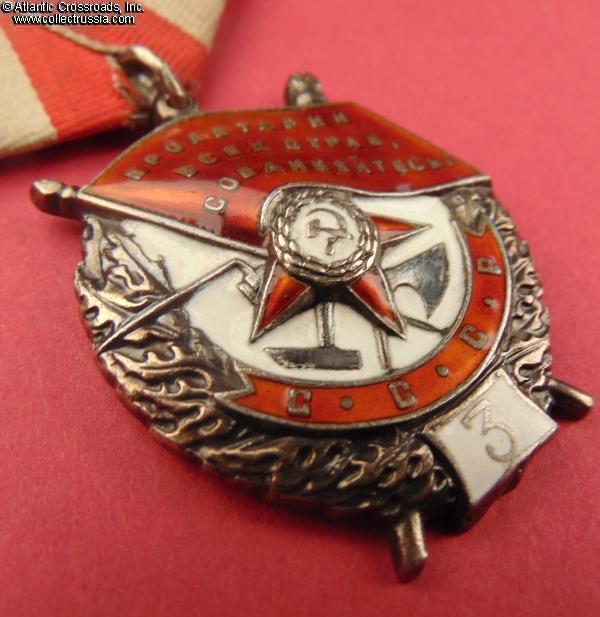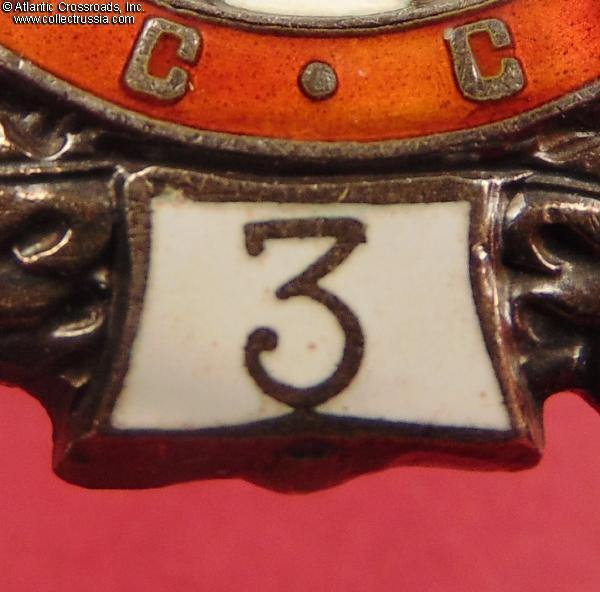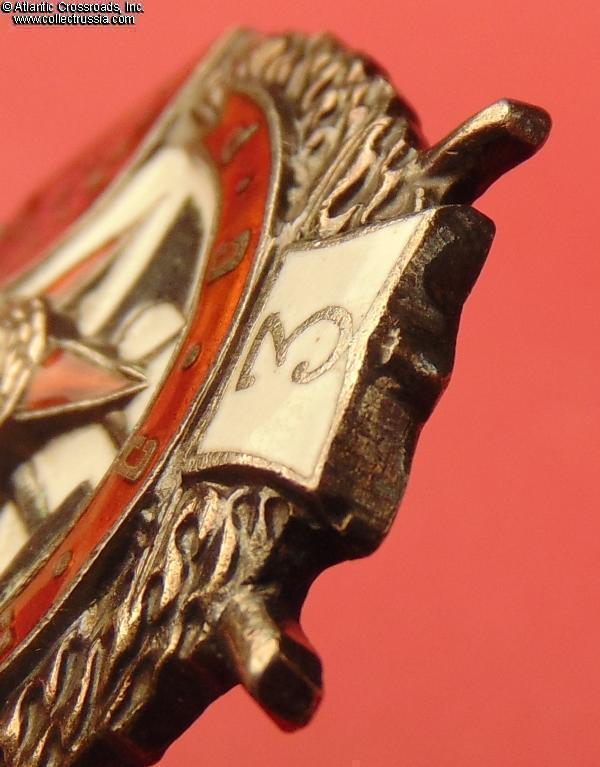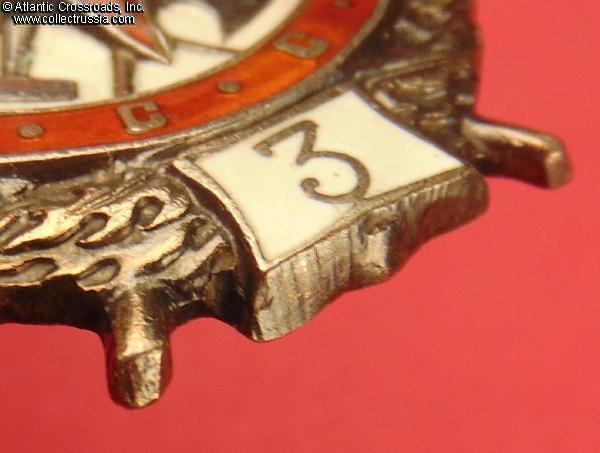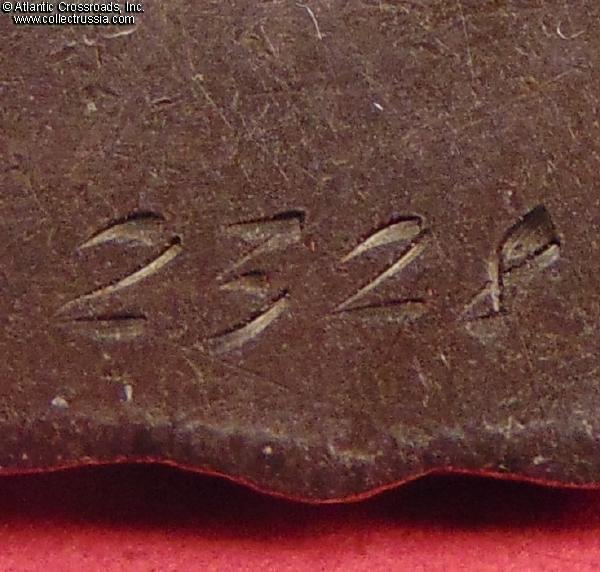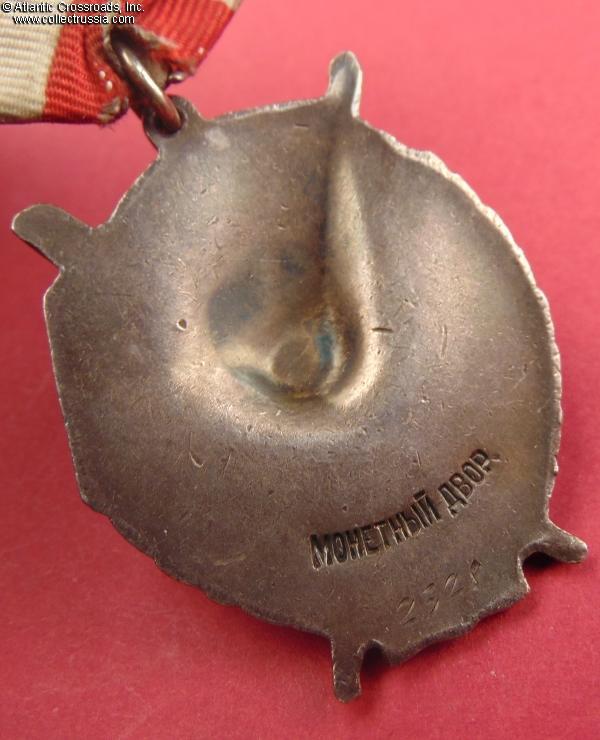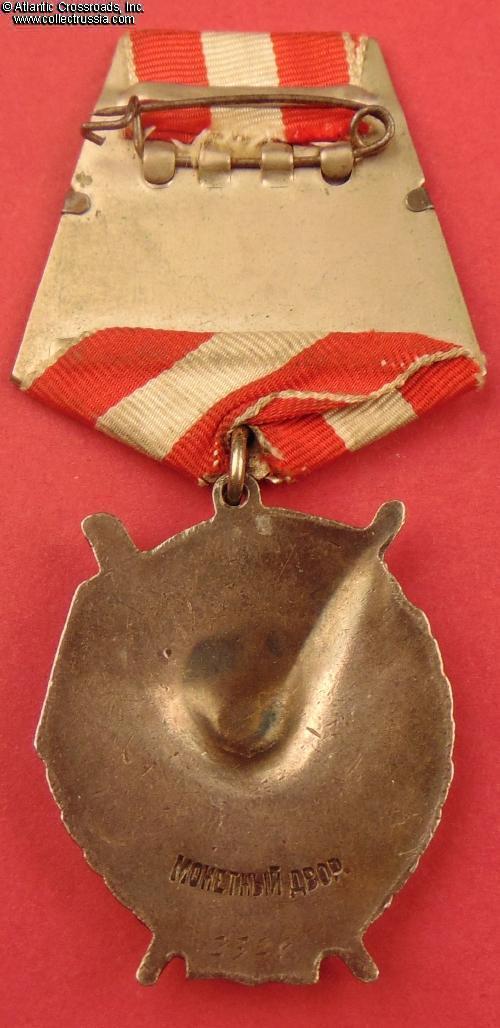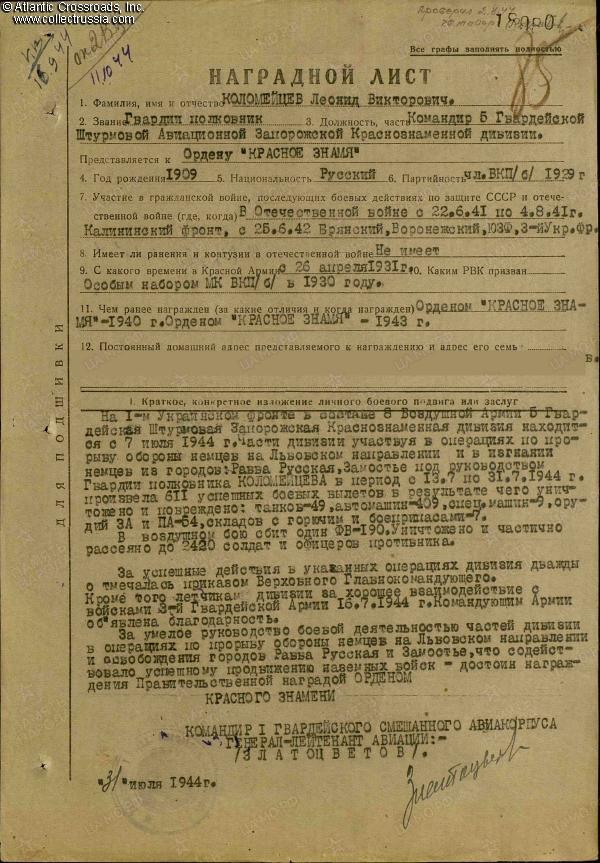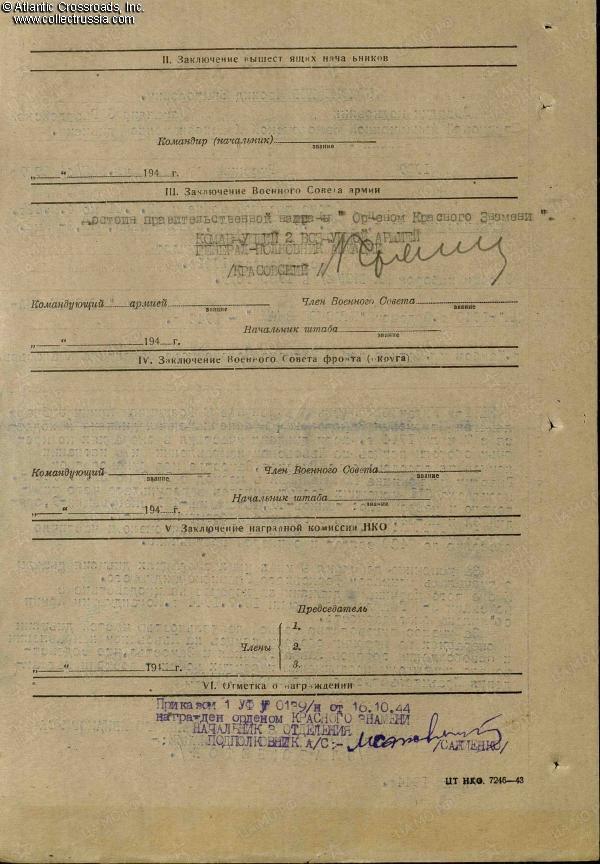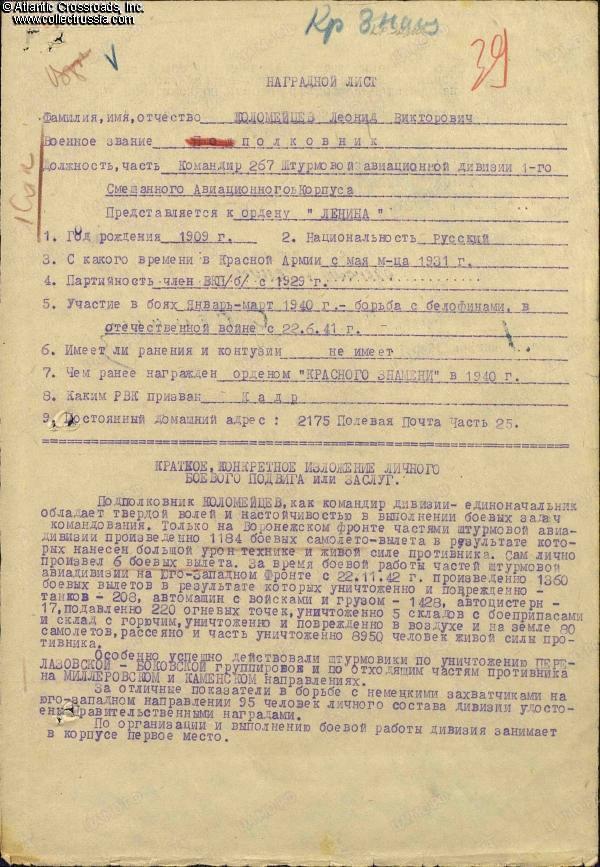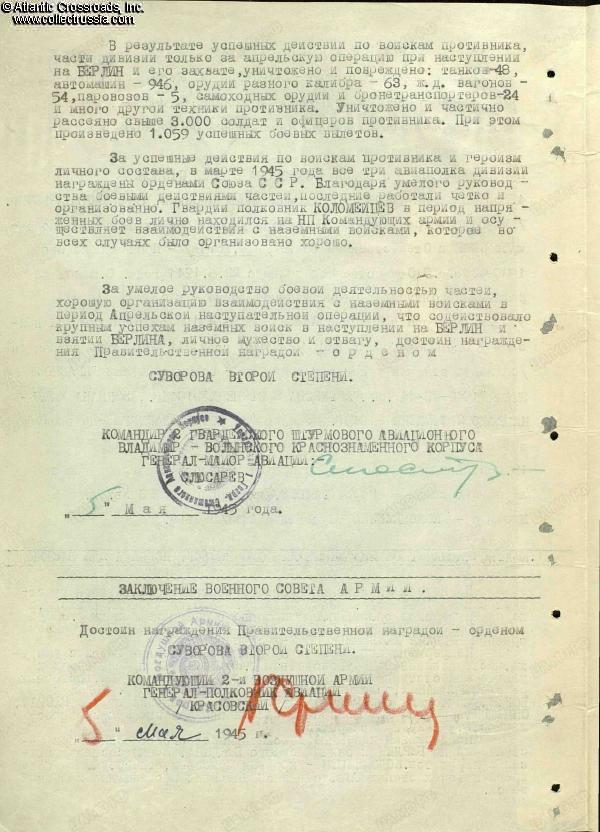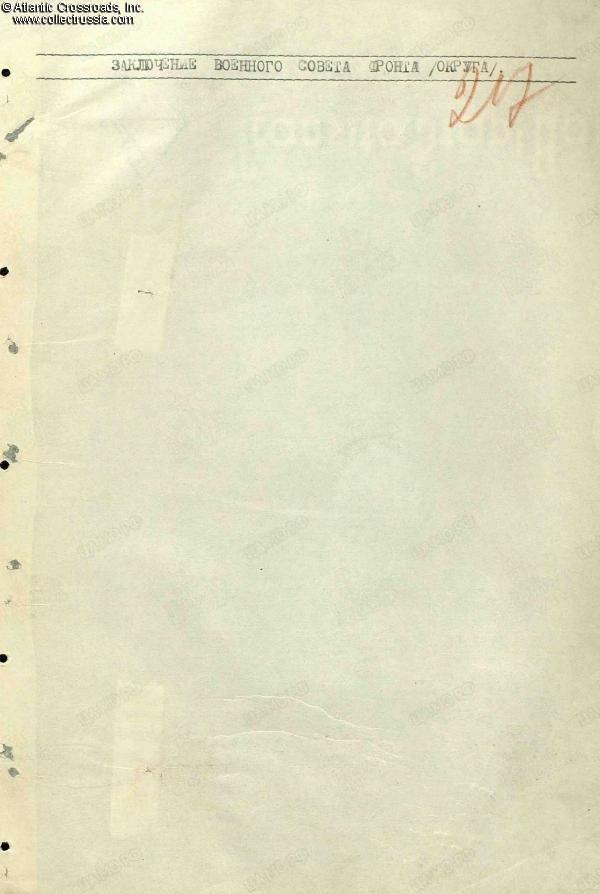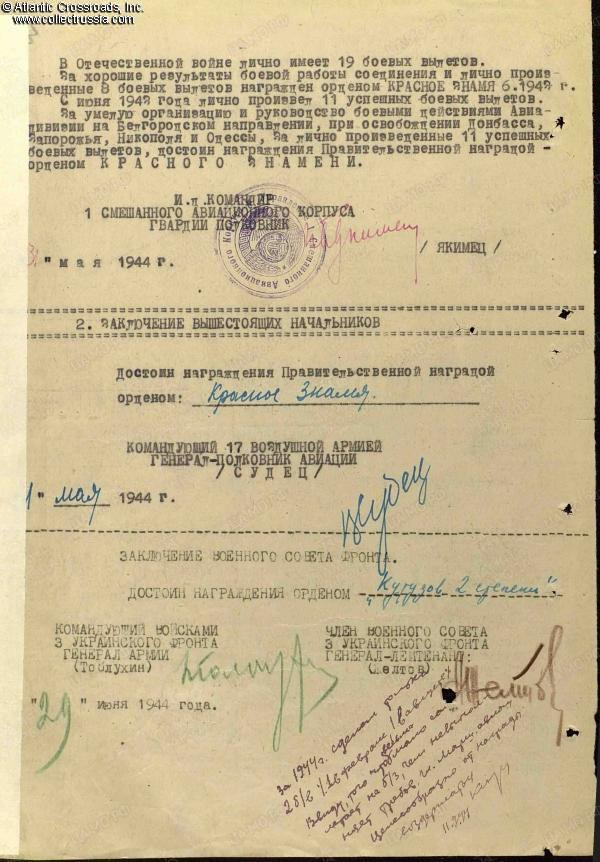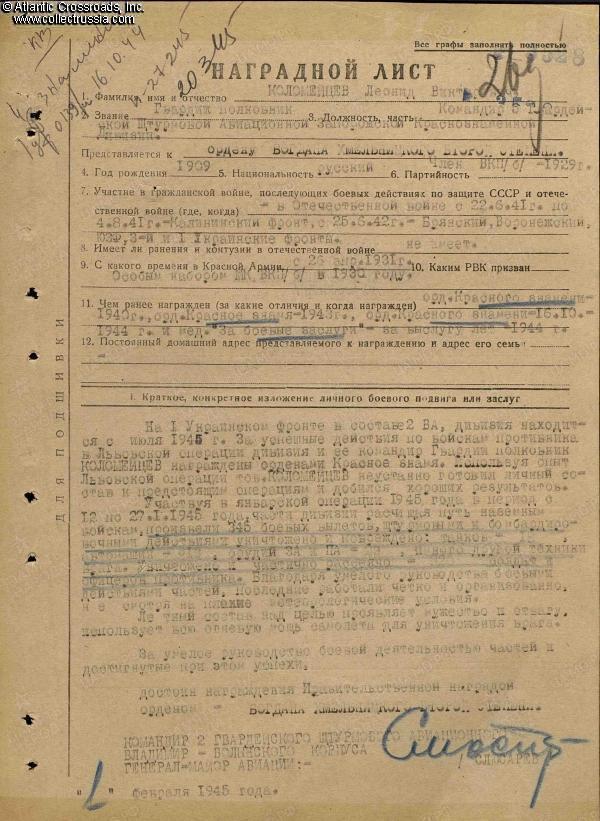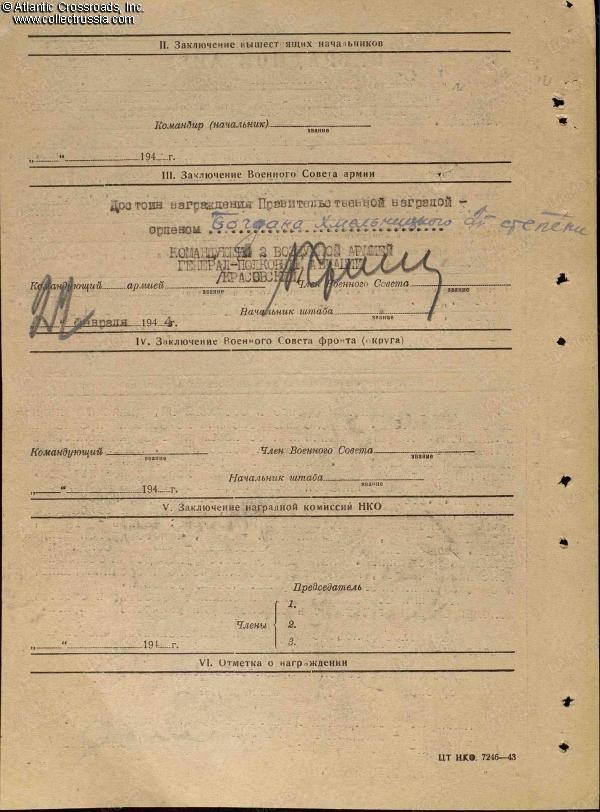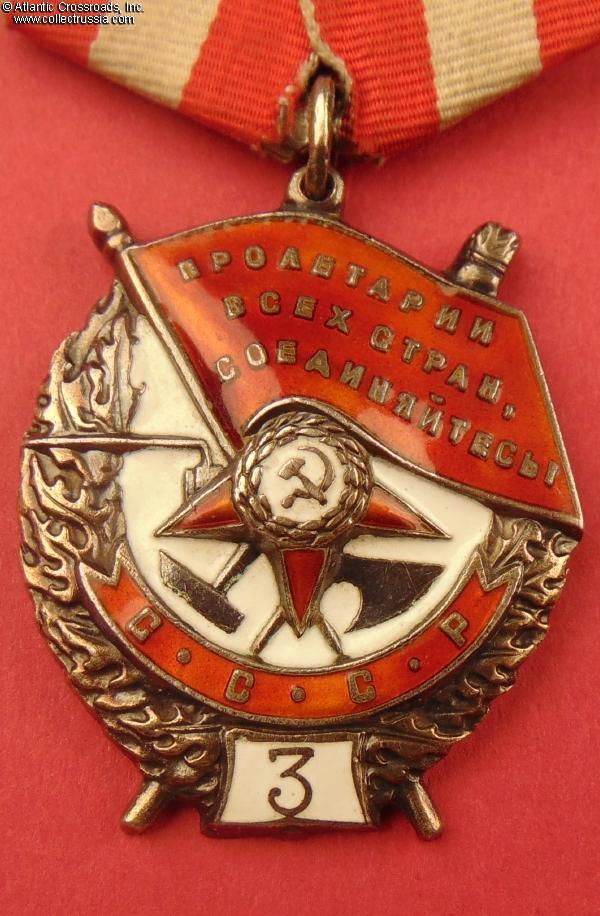
Order of the Red Banner 3rd Award, Type 4, Variation 2, Sub-variation 4, #2328, awarded on 16 October 1944 to Guards Colonel Leonid Kolomeytsev (Леонид Викторович Коломейцев), Commander of the 5th Guards Ground Attack Aviation Division, 8th Air Army, 1st Ukrainian Front.
Silver gilt, enamels; measures 45.0 mm in height (including eyelet), 36.9 mm in width; weighs 26.0 g not including the suspension and connecting link. This early version of the order features a very peculiar shape of the scroll with the numeral "3" unlike all other variations of the 3rd Award: its upper side is much smaller than the lower, the overall proportions are wider, and the numeral "3" is in comparatively thin lines and touches the lower edge of the scroll. The reverse is relatively smooth with a rounded depression in the center. The flames of the torch are rounded, lac
Silver gilt, enamels; measures 45.0 mm in height (including eyelet), 36.9 mm in width; weighs 26.0 g not including the suspension and connecting link. This early version of the order features a very peculiar shape of the scroll with the numeral "3" unlike all other variations of the 3rd Award: its upper side is much smaller than the lower, the overall proportions are wider, and the numeral "3" is in comparatively thin lines and touches the lower edge of the scroll. The reverse is relatively smooth with a rounded depression in the center. The flames of the torch are rounded, lacking the pointy upper segment. The mint mark is in a curved single line; its font is relatively large and the last character in the word "Monetnyi" has a straight dash over it. According to The Order of the Red Banner by Durov and Strekalov, this specimen is from the series with serial numbers from 2252-3851 manufactured at the Moscow Mint in 1945 (note that in here, as in many other cases, the decoration was awarded by an official decree long before it was manufactured and physically delivered to its recipient). It also must be noted that the actual number of issues of the Variation 2, Sub-variation 4 is much smaller than the serial number range would suggest: for unknown reasons, there are practically no orders with numbers 2700-3700 in existence (among other possible reasons, pieces with those numbers may have failed quality control and were subsequently scrapped.) Therefore, there were only approximately 600 specimens of this rare version ever issued.
In outstanding, excellent condition. The red enamel is literally pristine, completely free of even the microscopic contact marks that could be found under a 10x magnification, and shows a magnificent luster throughout. The white enamel has only a couple of microscopic contact marks in the center but appears to be perfect to the unaided eye. The original fire gilt on the wreath, flagpole, and torch is clearly visible although partly obscured by the silver patina. There is also a very attractive patina to the reverse. Comes on an original WW2-era suspension, a two-layer model in steel with a self-locking pin. The ribbon is old, likely original to the award; it shows a minor amount of soiling but is otherwise perfect and very attractive. The connecting link appears to be original as well; and its ends are still joined with solder in the characteristically seamless fashion of the Soviet mint production. To summarize, a superb example, literally impossible to upgrade condition-wise. Moreover, it is not only one of the relatively few wartime issues of the Red Banner 3rd Award, but also a very rare version of the 3rd Award.
Leonid Kolomeytsev was born in 1909 in a Kuban Cossack village in the Krasnodar (then Yekaterinodar) Region. In 1931, he enrolled in the 1st Myasnikov Military Pilots School in the town of Kacha. He graduated just a year later with an Air Force officer commission and qualification of a pilot; moreover, he apparently showed so much talent that the school retained him as a pilot instructor for a year. From 1933-39, Kolomeytsev served in heavy bomber and high-speed bomber units, rising from a pilot / airplane crew commander to air squadron commander. In 1939, he went through an additional training and then took part in the Winter War against Finland. During this conflict, he flew 35 combat missions in the area of Ukhta as a bomber squadron leader and was awarded with his first decoration, an Order of the Red Banner.
After completing a training program in the Lipetsk Advance Air Force Pilot School in September 1940, Kolomeytsev was appointed Commander of the 208th Long Range Bomber Regiment and was serving in that capacity at the start of the Patriotic War. On 30 June, on his first combat mission of the war, his airplane was shot down by an enemy fighter in the area of Dvinsk. Kolomeytsev got out alive from a hard landing but with severe burns and then, accompanied by another surviving crewman, for 24 days trudged through the enemy-held territory before he finally managed to cross the frontline to safety. In August 1941, he was temporarily appointed a deputy commander of the Tambov Pilot School - apparently to have a chance to recuperate from his ordeal - before being sent into combat again in March 1943 as commander of the 208th Ground Attack Aviation Regiment, 227th Ground Attack Aviation Division. As a part of the 2nd Air Army, the regiment took part in the defensive battles at Voroshilovgrad and Voronezh in the summer of 1942 during the opening phase of the German Operation Blau.
In August of that year, Kolomeytsev was given command of the 267th Ground Attack Air Division, 1st Combined Air Corps, 17th Air Army, a position he would hold through the end of the war. The division took part in the Battle of Stalingrad and later, provided ground support for the Soviet offensive towards Voroshilovgrad. By late January, it had completed 1184 sorties in support of the Voronezh Front and 1360 missions in support of the Southwestern Front during the Battle of Stalingrad and the pursuit of the retreating enemy at Millerovo and Kamenskoe. For his outstanding leadership during this period, Kolomeytsev was recommended for the Order of Lenin by the Commander of the 1st Combined Air Corps. The recommended decoration was however downgraded to the Red Banner by the Commander of the 17th Air Army Lt. Gen. Krasovskiy, and after an uncharacteristically long consideration by the higher command, Kolomeytsev received the Order of the Red Banner 2nd Award (#3449) on 17 June 1943. In the meantime, his division was elevated to Guards status for its outstanding performance and on 1 May 1943, received the new designation of the 5th Guards Ground Attack Aviation Division.
Throughout 1943-44, Kolomeytsev's division continued to fight with great distinction in support of the 3rd Ukrainian Front and was particularly effective during the liberation of Donbass and the cities of Zaporozhye, Nikopol, Apostolovo, and Odessa. In October 1943, it received the honorific title of Zaporozkskaya (i.e. "of Zaporozhye fame") and on 13 February 1942, was awarded with the Order of the Red Banner. Kolomeytsev not only showed excellent leadership qualities in all his unit's actions, but also flew combat missions himself, 19 in total, including 11 from June 1942 through April 1944. He was recommended for yet another Order of the Red Banner by but uncharacteristically, received the Order of Kutuzov, 2nd cl. (#2441) - far more prestigious but technically, lower award - in the end, based on the resolution of the Commander of the 3rd Ukrainian Front, General of the Army Tolbukhin. It is interesting to see that the original recommended award was rejected by one of the higher commanders who wrote: "It is advisable to hold off on the award because he .... personally flies combat missions in violation of the orders of the Chief Marshal of Aviation."
Despite the earlier "setback", Kolomeytsev soon earned his third Order of the Red Banner. In early July 1943, his division was transferred to the 8th Air Army of the 1st Ukrainian Front, and played a major role in the breakthrough of the German defensive lines at Rava-Russkaya (aka Rava-Ruska) and Zamostye in the Lvov region. On 16 July, the division received a special thank you note for its excellent cooperation with the ground troops, specifically the 3rd Guards Army. Within the last two weeks of the month, its pilots flew 611 combat missions destroying or damaging 49 enemy tanks, 409 motor vehicles, and 7 ammunition and fuel dumps. They also shot down a Focke-Wulf Fw 190 fighter - an unusual feat for Shturmovik pilots. On 16 October 1944, Guards Colonel Kolomeytsev was awarded with the Order of the Red Banner 3d Award by the general order #0139/n of the 1st Ukrainian Front.
In July 1944 the 5th Guards Ground Attack Aviation Division was resubordinated to the 2nd Air Army, still under the 1st Ukrainian Front. In January 1945, it took part in the Vistula-Oder Operation, destroying by the end of the month 18 enemy tanks, 23 artillery pieces, and 313 motor vehicles. Many of the 345 missions it completed during this period were flown in harsh wintry weather. For his leadership during the offensive, Kolomeytsev received the Order of Bogdan Khmelnitsky, 2nd cl. (#820). Kolomeytsev final combat decoration of the Patriotic War was the Order of Suvorov, 2nd cl. (#2474), awarded on 29 May 1945 for the performance of his division in the offensives in Poland, destruction of the encircled enemy troops in the area of Oppeln and Glogau (now known by their Polish names Opole and Głogów), and the capture of Berlin. It is noteworthy that all three air regiments within his division were awarded with state decorations for the Battle of Berlin.
Leonid Kolemeytsev remained on active duty in the military for a long time after the war, by 1948 reaching the rank of Guards Major General and position of Commander of the 4th Air Corps. After completing a course of studies at the Voroshilov General Staff Academy in 1949, he was appointed Deputy Commander of the 73rd Air Army, Turkestan Military District. From 1950-53, he was on a "special assignment" as senior military advisor in (supposedly) Czechoslovakia, and after his return to the USSR, commanded the 60th Guards Ground Attack Air Corps. In 1956, Kolomeytsev rose to command the air forces of the Siberian Military District and two years later, was promoted to Lieutenant General. He retired with full honors in 1961, having added to his extremely impressive list of WW2 decorations a number of awards received in the post-war years, including the Order of the Red Banner 4th Award (#1820). After his retirement he lived in Kiev, where he for 20 more years worked as the chief of air defense at the Radio Electronics Factory. He passed away at the age of 82 in 2001, long after the collapse of the USSR.
Research Materials: photocopy of the award record card and award commendations for the combat awards of the Patriotic War period listed
above, including the Orders of the Red Banner 2nd and 3rd Award; and Orders of Suvorov, Kutuzov, and Bogdan Khmelnitsky, 2nd cl. Many
additional details of Kolomeytsev's biography including his post-war career are available from the Russian-language Wikipedia and many other
Internet sources.
$3,550.00 Add to cart

